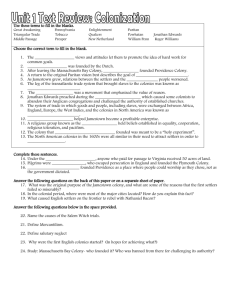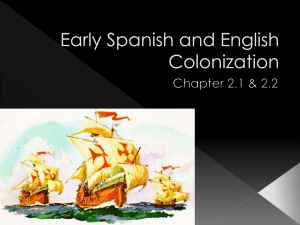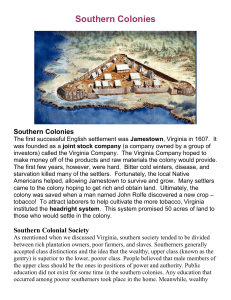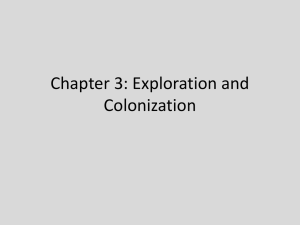Early Colonial America - Faculty
advertisement
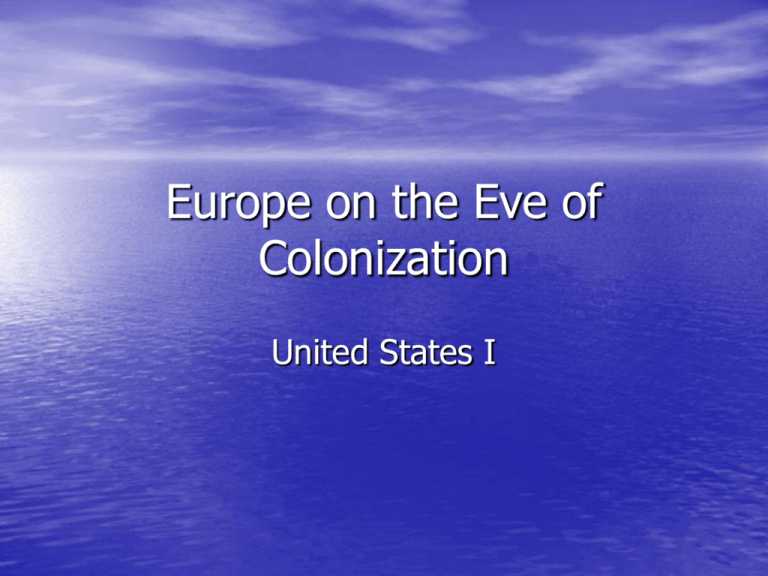
Europe on the Eve of Colonization United States I Europe in 1400 • Very backward place • Most Europeans, like most Native Americans were simple farmers • Outside the primary Asian trade routes – Muslims controlled trade with Asia – Europeans wants spices and exotic products Economic Growth • European economy grows during Middle Ages • Population growth—begins to recover from • plague Unlike China, no European nations possessed a self-contained economy. – All needed to trade with each other and outside • Competed with each other for access to resources and mastering new military techniques—long term benefit Impact of the Crusades • Taste for exotic products • Experience running sugar plantations • Desire to move away from the control of Italian city states Portugal leads the way • Rather Surprising • Small kingdom—fewer than 1 million citizens • Recently united-Muslims driven out • Maritime traditions lagged behind other regions • Small merchant class-little capital • However—Excellent Location!!! Prince Henry the Navigator • Member of Portuguese Royal family and member of crusading religious order (Order of Christ) • Used revenues from order to sponsor 15 voyages along the African Coast Advancements by Portugal • Ability to navigate high seas beyond sight of • • • • land Capacity to defeat any non-European fleet on the world’s oceans. Mapped the prevailing winds and currents of the oceans Copied Arab ship designs—improved for open ocean travel. Learned to mount heavy cannons on the deck. Slave Culture • Developed sophisticated slave culture – Supported exploration with sugar plantations of offshore islands • 1st acquired slaves by capturing on African coast – Raids upset coastal people • After 1450, developed slave trade structure – Small forts—factories – Buy slaves from local rulers • Nearly all slaves in the Atlantic slave trade were enslaved by fellow Africans. – Europeans exploited rivalries Economic Impulse • Precious metals was the initial impulse • Crops and slaves kept the motivation alive – Before 1800’s, more than 2/3 of people who crossed the Atlantic were slaves. – Important to remember that Atlantic slave trade was not some exception to the story of freedom and liberty, it was the norm • Few Europeans who crossed expected to work – Men of prestige and wealth simply did not do physical labor Spanish Exploration • Spanish moved more slowly than Portuguese • Unification of Castile and Aragon • Strong crusading tendencies – Desire to spread Christianity to wider world – Desire for wealth and commercial opportunity • Environment that producing Conquistadors Christopher Columbus • Italian by birth, Portuguese trained • Wants to sail west—Portuguese laugh • Circumference of the globe • Makes plea to Spanish crown • “Throw-away” fleet of three ships Columbus • Lucky he ran into Americas • Believed he found Asia—actually islands in the Bahamas • Returned three more times – Never finds riches Spanish government demanded Conquistadors • Discoveries unleashed a horde of conquistadors on the Caribbean – Not seeking permanent society – Just plunder • In less than 20 years, natives exterminated • Some move to mainland – Hernan Cortes--Aztecs Impact • Over 450,000 migrants between 1492-1650 – Mostly single men – Most intermarry with Indians and blacks • Spain regarded Americas as source of precious metals – Between 1500 and 1650 shipped 200 tons of gold and 16,000 tons of silver • Fail to develop industry—just depend on annual shipments from America. English join the game • English get involved in international activities in the 1500’s • Moscovy Company—Northern route to China around Scandinavia • Martin Frobisher—search for the Northwest passage English exploration • Projects to the Americas received strong, but unofficial support • Too weak to challenge Spain openly, but wanted to break Spanish monopoly in New World • Elizabeth I encouraged “Sea Dogs” to attack Spanish shipping Economic Growth • England building a strong commercial class – Prosperity built on wool and coal production – Growing industrial production • Interest in colonial development to expand economy – Provide outlet for excess population – Source of raw materials – Buffer against Catholic expansion Irish Experiment • England’s first colony was Ireland • Learned to subdue a population and seize its lands – Seized large parcels of land from Irish – Established semi-military “plantations” • Served as model for later colonies in the new world – Compared Native Americans to the “Wild” Irish Sir Humphrey Gilbert • Oxford Educated soldier • Experience with English conquest of Ireland—tolerated no opposition • Secures Royal patent to develop colony in Americas • Set up expedition in 1583 – Lands in Newfoundland – Lost at sea Unpromising Start • By 1570’s English ready to begin challenging Spanish control over Americas • English adventurers make series of mistakes between 1575 and 1600 • Gain valuable information about seas, supplies and finance Sir Walter Raleigh • Provided example of what not to do • Ventures encouraged, but not funded by crown • Sends of expedition to Virginia region, named • after Queen Elizabeth In 1585, sends expedition under Richard Grenville to Roanoke Island – Colonists do rather well, but fail to get re-supplied – Return home with Francis Drake in 1586 Lost Colony • • • • • • • • In 1587, launched 2nd venture Includes men, women and even children Under leadership of John White Returns to England for more supplies and colonists War with Spain prevents return until 1590 Find colony deserted “CROATAN” carved into tree. Fate of “lost” colony remains a mystery. – Best guess—absorbed into neighboring groups of natives Richard Hakluyt • English writer • Never visited America—shapes English public opinion toward colonization • The Principall Navigations, Voyages, and Discoveries of the English Nation (1589) • Theme—England needed American colonies – English settlers would provide natural resources and grow rich in the process – Painted a picture of paradise on earth • Jamestown would show the harsh realities Problems • Individuals could not support colonies • Merchants more interested in Mediterranean and Russia • Need for an influx of capital to make colonization work. • Finally happens in early 1600’s. Virginia Company • 1606, King James chartered Virginia Company to colonize North America – Two Headquarters—Plymouth and London • Plymouth Company tries colony in Maine – Abandons in a year Joint Stock Companies • Moved away from individually sponsored colonies • Sold shares to investors to raise money • Investors expected to profit in return • Spread out responsibility • Little chance for profit in early colonies London Company • Decided to colonize Chesapeake Bay area. • Sent out 3 ships and 104 men • Settled on peninsula in the James river. – Searching for gold and silver – Cure for syphilis – Planned to force Indians as laborers Jamestown • Jamestown was a deathtrap • Only 38 of original 104 survived the first year. • Colony had too many gentlemen and specialized • craftsmen (perfumer) Survivors owed their existence to John Smith – Dedicated himself to survival of community – Work at least 4 hours per day Continued Chaos in Jamestown • London Company sends over more settlers • John Smith injured-returns to England • Settlers provoke war with Natives • 1610 settlers ready to abandon settlement • In nick of time, new governor arrives – Martial law – Expanded settlements – Tobacco—John Rolfe Shift in policy • Experimented with harsh military discipline • “Lawes Divine, Morall and Martiall” • Tended to discourage immigration London Company • London concerned about disintegration • New Settlers arrived only to die • Facing financial ruin – Concealed state of affairs • Desperately looking for marketable product Land Policies • First Settlers expected to work together – Work for food • Governor assigned land in small plots to • colonists who finished their terms of service In 1616, Company instituted the Headright system – 50 acres to anyone who paid their way to Virginia – 50 more acres for each additional person Changes in 1619 • Company began transporting women • Created 1st legislative body in English America – House of Burgesses • Landowners elected • Subject to approval of company • Settlers still having problems making a profit • Headright system expanded out the colony—less control over widely spread colonists. • Further strained Indian relations War with Indians • Warfare was on-going throughout much of the early history of Jamestown • Union between John Rolfe and Pocahontas temporarily calmed events • Revived in 1622 • Brutality on both sides • Colonist forced behind fortified walls • Economic activity ceased • London Company went bankrupt • 1624—King James dissolves company – Virginia now a royal colony Search for marketable product • 1610 Start growing tobacco – Popular with wealth English society • 1617 1st cargo arrives in England – Very profitable • Settlers start planting everywhere – Supply and demand Tobacco • Shaped every aspect of Virginia society • Grabbed land close to rivers • Necessitated a large labor force – 9 month a year crop Help Wanted! • Need labor to make a profit • Imported indentured servants • Between 1625-40, 1000 servants arrived each • • • year Mostly young males—best workers Ultimately, reality scares off pool of indentured servants Plantation owners need to look for new labor source Maryland • Different origins than Virginia but much the same outcome • Vision of George Calvert—Catholic refuge • Charter in 1632—Sweeping powers • Economically in quickly focuses on tobacco Lord Baltimore’s plan • Set up feudal manors in the wilderness • Problem—Few Catholic emigrated to America • Most settlers were Protestants • Social and religious resentments strong in the colony New England colonies • Appropriate –others colonies produce “Non-English” goods, N.E. reproduces mixed economy • Disagreement with England over religion, not economics • Wanted to worship as God commanded not how C. of E. required. English Reformation • Anglican church closely resembled Catholic church • ‘Middle way” satisfied most but not all • Puritans felt reforms did not go far enough Puritan Demands • Purify the church by: – Eliminating Bishops – Simplifying church services – Emphasizing God’s control – Emphasis on hard work Pilgrims • 1606—church in Nottinghamshire leaves C of E • 125 members go into exile in Holland • Holland not a “good fit”—Too liberal • Negotiated with Virginia company for possible travel to America Travel to America • Short on cash • Form joint stock company with perspective emigrants and investors • Agree to pay ½ of future profits • 1620-Mayflower 100 settlers, only 35 Pilgrims America • Land at Cape Cod Bay—North of Virginia • • • Company territory Decide to stay—late in season Since outside Virginia Co.—some feel free of all gov. controls Mayflower Compact—bound all to decisions of the majority – Set precedent—set of rules selected by members New Colony • Arrive in December—tough winter – ½ die including governor – William Bradford takes over • Settlers get lucky – Squanto • Gain political autonomy and private ownership within 10 years Popular Image of the Puritans Popular Image of the Puritans • Nagging critics who condemned liquor and sex • Dressed in drab clothes • Minded their neighbors business • Reflects a fundamental misunderstanding of Puritanism Reality • Radical reformers • Seeking to bring about fundamental change • Like Pilgrims, products of Protestant Reformation • Concept of Pre-Destination—refused to wait until Judgment Day • Examined themselves for signs of grace— for hints of being one of the “elect” • Church of England needed reforming • Needed to speak out • There goal was not to leave the church, but reform it from within • Often with combative means • Under Stuart Kings in England, saw little chance for reform • Feared God would punish England, but spare Puritans • Puritan leaders starting to look for new home • America? • In March 1629, Massachusetts Bay colony obtains a charter from the king • King probably believed he was signing just another commercial venture • It was a typical joint stock company, except for one clause • Could hold stockholder meeting anywhere • 1st group set sail in March 1630 • By end of 1st year, almost 2,000 arrived at Mass. Bay • Moved to America as nuclear families • Most survived, in fact thrived • Life expectancy much longer than normal Concept of Covenant • Common sense of purpose helped to tie the community together • Believed they had a “special covenant” (agreement) with God. • Live according to scriptures City On a Hill • Establish a model community • Beacon of righteousness for the rest of the Christian world • If they kept the bargain—assured peace and prosperity • Convert religious vision into social reality Church Plan • Precise plan for the church in America was unclear • Evolution of Congregationalism – Each village was free from outside interference – To be member of church, men and women needed to testify to faith publicly Puritan Life • Exalted individualism but not by our standards – Too much self emphasis dangerous to the community – Residents closely monitored each other behavior • Towns banished those who violated community standards Banishment • Tolerance of difference was not high on Puritan list of values – Criticizing church or government – Letters home – Anti-social behavior Religious Differences • Difference of opinion arose almost immediately • Emphasis on individual interpretations of bible allowed fragmentation – 1st sustained criticism—Roger Williams • Challenged church beliefs and concept of “elect” • Strengthen church by including only those of pure faith Roger Williams • Banished in 1636 • Move to establish colony in Rhode Island • Becomes beacon for religious freedom – No established church – No religious qualifications – No requirement to attend church Anne Hutchinson • More threatening to Puritan establishment – Woman of influence • Mid-wife and daughter of clergy – Strong personality • Started holding home meetings to discuss religious issues, then community issues Hutchinson’s theology • Emphasized grace over good works – Questioned emphasis on church attendance and moral behavior • Put on trial for sedition (dangerous views) • Combative and articulate • Loses support—direct messages from God • Banished—Rhode Island, then Long Island Status of Community • By mid 17th century, concerns about declining piety – By 1650, less than ½ the population were admitted as full members of church – Tough questioning by clergy and church elders discouraged joining • Hard to force non-members to attend church • Even harder to refuse to let taxpayers have a vote because of non-membership • Many children of the “elect” were baptized but never became members – What about their children? • Could not be baptized – Holding to existing standards would limit size and social influence of the church Half-Way Covenant of 1662 • Permitted baptism and partial membership of grandchildren of those who emigrated in Great Migration • Right to vote was extended to members • Ancestry, not conversion, was pathway to elect Economic Development in New England • First hoped to develop a self-sufficient, producing most of its own manufactured items • Then tried to exploit the fur trade – Short-lived venture • Ultimately moved into indirect trade schemes Triangle Trade • Complex, multi-leg trading network linking New England, West Indies, Africa, Europe and England. • Goal was to end up with something that could be exchanged for English manufactured goods – Didn’t matter what they started with or how many stages along the way. Rise of Port Cities • With growth of maritime trade, wealth and power began to congregate in port towns. – Portsmouth, Salem, Boston, Newport, New Haven • Largest and most thriving city was Boston – Population of over 10,000 – Third largest ciy in British Empire

